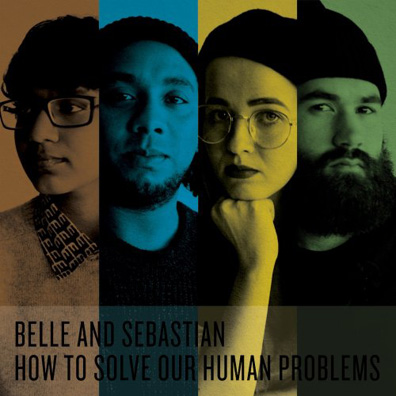
Belle and Sebastian
How to Solve Our Human Problems Parts 1, 2, and 3
Matador
Feb 26, 2018
Web Exclusive
![]()
When Belle and Sebastian released their ninth studio album, Girls in Peacetime Want to Dance, in 2015, many fans weren’t expecting the slew of dance-centric tracks that made up the album’s critical success. Now three years later, Belle and Sebastian return to the dancefloor fray with new music, in the form of three connected EPs released over several months and also collected as a compilation CD and in a vinyl box set. Entitled How to Solve Our Human Problems, this EP trilogy takes after their three 1997 EP releases, and sees the band dip back into tracks from their extensive backlog. Each of the three EPs revolves around a “showroom” track, one track that in some way inspires or connects the rest of the songs on that particular EP; a track that the band had, up until now, kept in B-side territory; a track now getting its moment in the sun.
For Part 1, that focal point is “We Were Beautiful”—an energetic, yet somehow strangely mournful, dance track on an EP that sounds still very much in the disco neighborhood of Peacetime. “Sweet Dew Lee” is a groovy romanticized account of a loner’s longing for an impossible love. Softer song “Fickle Season” is reminiscent of Peacetime‘s lighter side, and that classically harmonious and symphonic Belle and Sebastian sound. Part 1 serves as a strong opening of well-put together songs, albeit a little disparate, for a group who are still eager to take new risks.
Part 2 features a slightly more cohesive tracklist. The group displays their maturity with a collection of songs that play more like a mini-album than a swath of singles or studio experiments. This EP’s first two songs seem like a set-up for “I’ll be Your Pilot,” a beautiful and introverted song about the love a father has for his son. Stuart Murdoch sings with aged wisdom, addressing his child, “It’s tough to become a grown-up/Put it off while you can.”
The musical DNA of Part 3 dips back into the dance-pop world of Part 1. “Poor Boy” is an electro-disco anthem, the likes of which Belle and Sebastian fans might recognize as vastly different from the band’s past work. Part 3 also features the most diverse range of genre, style, and lyricist: in classic Belle and Sebastian fashion, the collaborative arm of the band’s songwriting process and aesthetic is in full force.
How to Solve Our Human Problems is difficult to pin down. In some ways, Belle and Sebastian’s new work represents unexplored territory—yet, the group have been around for so long that one could find elements of nearly every one of their last albums in the 15 collected tracks of this EP trilogy. “Wisdom is the mind at ease,” sings Murdoch on “Everything is Now (Part Two).” How wise this group certainly is. (www.belleandsebastian.com)
Author rating: 8/10
Average reader rating: 9/10
Current Issue

Issue #72
Apr 19, 2024 Issue #72 - The ‘90s Issue with The Cardigans and Thurston Moore
Most Recent
- Sam Evian on “Plunge” (Interview) — Sam Evian
- Maya Hawke Shares Lyric Video for New Song “Hang in There” (News) — Maya Hawke
- Premiere: Anna Tivel Shares New Single “Desperation” (News) — Anna Tivel
- Nilüfer Yanya is a Runaway Bride in the Video for New Song “Like I Say (I runaway)” (News) — Nilüfer Yanya
- Storefront Church Announces New Album, Shares New Song “Coal” (Plus Live Video) (News) — Storefront Church

Comments
Submit your comment
There are no comments for this entry yet.